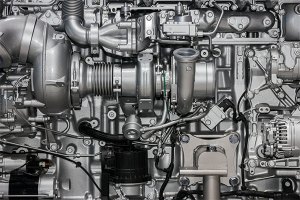
Getting to know the electrical system
Which electrical component is the primary power source for a vehicle when it’s running?
- Starter motor
- Battery
- Alternator
- Engine
If you chose alternator (C), you’re correct. The alternator is an essential part of the electrical system that provides power to a running vehicle. Without it, and other essential elements like the starter and battery, your vehicle wouldn’t turn on, and many components wouldn’t operate correctly. Learn more about how a truck’s electrical system operates and get tips for preventing breakdowns.
Main components of the electrical system
The electrical system is primarily composed of the starter motor, battery and alternator. These three parts are responsible for starting the engine, keeping it running and powering all electrical components like the radio, lighting, windows, locks, windshield wipers, air conditioning and more. The information below can help you understand the function of each.
Starter motor
The starter motor, also referred to as the cranking motor, converts electrical energy into mechanical energy via the starter relay and starter solenoid. It then provides electricity to the pinion gear and flywheel, which turn the engine over to start the vehicle. Here’s how it works:
- The key is inserted into the ignition, and the battery sends a low-voltage electrical current to the starter relay
- The starter relay energizes the starter solenoid, which converts electrical energy into mechanical energy
- The mechanical energy engages the pinion gear toward the flywheel
- The pinion and flywheel mesh together to turn the engine over
- The engine starts, and the starter disengages
Indicators of a faulty starter
The starter motor may be experiencing problems if:
- It doesn’t activate instantly when the key is inserted into the ignition
- There’s a clicking or whining sound when turning the key
- Smoke rises from the starter or starter circuit
Battery
The battery is considered the most important electrical component because it allows the vehicle to start. This device also stores energy when the engine is off, which allows drivers to connect an inverter and power items such as radios, televisions and microwaves even when the truck is powered down — a beneficial function for long-haul drivers.
Indicators of a faulty battery
There’s likely a problem with the battery if:
- The engine is slow to crank or won’t start
- The battery light comes on
- There’s a strong sulfur smell
- The battery chemicals are leaking
Alternator
As mentioned, the alternator is the primary power source for the entire vehicle when it’s running. It converts the mechanical energy from the starter back into electrical energy to simultaneously power electrical accessories and charge the battery. When the engine is running, the alternator is what keeps the vehicle from shutting off.
Indicators of a faulty alternator
Signs of a defective alternator include:
- Unusual grinding noise under the hood
- A dead battery
- Loss of power in the engine
- Dim or flickering lights
How to maintain vehicle electrical systems
Over time, factors like vehicle age, mileage and daily driving conditions can affect your electrical system and keep it from starting or operating normally. By implementing regular maintenance, you’re more likely to find and fix potential problems before they turn into major issues. Use the tips below to maintain the electrical system:
- Inspect and clean the battery cables
- Check for loose plugs and wires
- Make sure all lights are off when vehicle isn’t running
- Start a preventive maintenance (PM) plan with FleetNet America®
Let FleetNet America® help
You never know when your electrical system could malfunction. Because of this, consider implementing a PM program with FleetNet America. We will monitor and preserve all electrical components by regularly:
- Keeping all parts free of dirt, grease, dust and corrosion
- Making sure all belts are secured in place and free of wear and tear
- Maintaining the batteries and cables
For more information about how FleetNet can service your electrical system, call 855-836-3912.
If you have any questions about your vehicle’s electrical system, leave a comment below — we’ll get back to you shortly.
